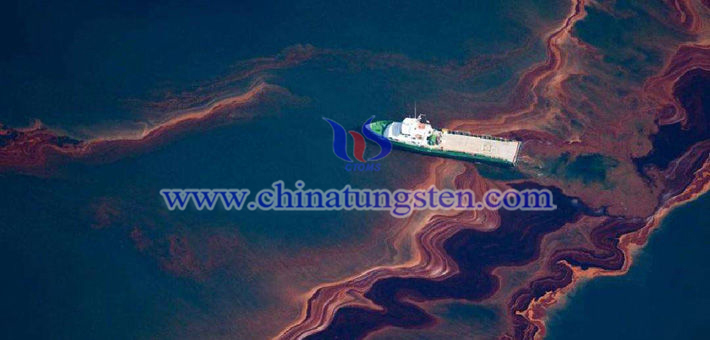Tungsten Oxide to Be Used In Oil Spill Treatment
- Details
- Category: Tungsten Information
- Published on Wednesday, 08 August 2018 19:16
Tungsten trioxide can be applied to the emulsion separation process in water pollution control, mainly to solve problems such as industrial oily wastewater and oil spill.

As is well known, tungsten trioxide (WO3) is an extremely common n-type semiconductor material with excellent photoelectric properties and has broad application prospects in many fields, for example, as a raw material for the preparation of tungsten products, for sulfur measurement by coulometric titration. It plays a catalytic role and acts as a catalyst for a wide range of applications in hydrodesulfurization, SCR denitration, photocatalysis, etc. It can also be used for the function of insulating and warming the smart glass.
However, what you may not know is that tungsten trioxide is also a hydrophilic material. Of course, there are certainly many other materials that also have inherent wettability, such as hydrophilic metals and their oxides, hydroxides, and hydrophobic fluorine-containing compounds.
The main application of tungsten trioxide is emulsion separation. A high-moisture stainless steel mesh was coated with a layer of tungsten trioxide film with extremely wettability consisting of micron-sized blocks. The film's underwater oil droplets have a contact angle of up to 155° and exhibit good underwater oleophobicity. So, what is the separation ability of the film for a general oil-water mixture and an oil-in-water emulsion? The tungsten trioxide film can effectively separate simple, layered oil-water mixtures and oil-in-water emulsions by gravity alone. Rely on gravity? How to look at it feels so magical and effective! So why choose tungsten trioxide? This can be seen from the background of its application in emulsion separation.
Water pollution has always been a serious problem that needs to be dealt with for a long time, especially when the continuous discharge of industrial oily wastewater and various oil spills occur frequently. The problem of water pollution is not the case today. There are many ways to control it. However, for oily wastewater, in recent decades, people have tried to solve this problem through various methods, such as oil recovery boat, centrifugal and flotation, etc. However, these methods are only suitable for separating simple layered oil-water mixtures and are not suitable for emulsion-like oil-water mixtures. In conventional emulsion separation processes, it is generally desirable to first convert the otherwise stable emulsion to a layered oil-water mixture by using a powdered demulsifier. This process is complicated and not suitable for large-area use.
With the continuous development of wettability-related research, it has been found that emulsion separation using a membrane with extreme wettability (superhydrophobic-super-lipophilic and superhydrophilic-underwater superoleophobic) is a very simple and effective method. At this time, researchers who have an understanding of tungsten trioxide began to study this characteristic (wettability), which led to the application of tungsten trioxide in emulsion separation.
Of course, there are other films that can be implemented. A superhydrophobic polymer/carbon nanotube hybrid film is obtained by a covalent bonding process of a hydrophobic polymer. This superhydrophobic-superlipophilic membrane can be used to effectively separate different types of water-in-oil emulsions. A layered porous silica nanofiber membrane having underwater superoleophobicity is obtained by in-situ growth, which enables efficient emulsion separation. Compared with the membrane with superhydrophobic-super-lipophilic properties, the obtained super-oleophobic membrane can retain the water layer on the surface due to its strong hydrophilicity, forming a solid-water composite interface and preventing oil. Adhesion to the film, thereby increasing the useful life of the film. Metal mesh, due to its excellent mechanical properties, has become one of the most widely used materials in the field of oil-water separation. However, for emulsion separation, the ordinary metal mesh has a relatively large pore size and is difficult to use directly. Generally, it is required to cover the surface with a material having extreme wettability to reduce the pore diameter. For metal mesh, 2300 mesh stainless steel mesh has been widely used in emulsion separation due to its unique weaving method and small pore size. This layer of material with extreme wettability is selected as tungsten trioxide.
- Tungsten Oxide Manufacturer & Supplier, Chinatungsten Online: www.tungsten-oxide.com
- Tungsten News & Prices of China Tungsten Industry Association: www.ctia.com.cn
- Molybdenum News & Price: news.molybdenum.com.cn
- Tel.: 86 592 5129696; Fax: 86 592 5129797; Email: sales@chinatungsten.com



 sales@chinatungsten.com
sales@chinatungsten.com